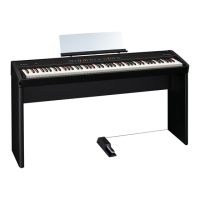Error Messages
Display Meaning
Error 1 The music le you attempted to save is read-only. It cannot be saved.
Error 2
An error occurred while writing. It may be that the protect tab of the external media is in the “Protect (write prohibit)” position, or that the
external media has not been formatted.
Error 10 No USB ash drive connected. Connect a USB ash drive and try the operation again.
Error 11
There is insucient free space at the save destination. Either connect a dierent USB ash drive, or delete unwanted data (song data, registration
sets) and try the operation again.
Error 14
An error occurred while reading. The USB ash drive may be damaged. Connect a dierent USB ash drive and try the operation again. You may
also format the USB ash drive (p. 36).
Error 15 The le could not be read. The data format is not compatible with the FP-50.
Error 16
The data could not be read fast enough during song playback. After waiting several seconds, you may be able to play back the song by pressing
the [
] button once again.
Error 18 This audio format is not supported. Please use WAV format, 44.1 kHz, 16-bit linear audio les.
Error 30 The FP-50’s internal memory is full.
Error 40
The FP-50 cannot deal with the excessive MIDI data sent from the external MIDI device. Reduce the amount of data being transmitted by the
external MIDI device.
Error 41 A MIDI cable was disconnected. Connect the MIDI cable correctly.
Error 43 An error occurred during MIDI communication. Check the MIDI cable and the connected MIDI device.
Error 46 The access point is not supported. Please use WPA or WPA2 authentication.
Error 51
The system may have malfunctioned. Try the operation again. If this indication still appears after trying the operation several times, contact
Roland Service Center.
Error 65
The USB MEMORY port was subjected to excessive current. Verify that there is no malfunction in the USB ash drive, and then turn the power o,
then on again (p. 13).
Saved Settings
Settings Saved in Registrations
Setting Explanation Page
– Selected tone p. 14
– Dual play on/o p. 14
– Tone 1/Tone 2 (Dual play) p. 14
– Split play on/o p. 15
–
Right-hand tone/Left-hand tone (Split
play)
p. 15
– Split point p. 15
–
Transpose’s on or o, its value, and
Transpose mode
p. 18
– Ambience on/o and depth p. 17
–
The Volume Balance between Your
Keyboard Performance and the
Accompaniment
p. 8
– Rotary eect’s pulse speed p. 14
Modulation Speed Speed of sound modulation p. 14
KeyTouch Key touch p. 18
Rhythm Rhythm settings p. 19
Dual Bal Dual balance p. 38
SplitBal Split Balance p. 38
Ambience Ambience on/o and depth p. 17
AudTrans Audio transpose p. 23
Trnspose Transpose mode p. 38
Oct Shft Octave shift p. 38
SplOnRcg Recognize split on chord recognize p. 39
DPdl Prt Setting for the damper pedal part p. 39
CPdl Prt Setting for the center pedal part p. 39
CPdl Fnc Function of the center pedal p. 39
LPdl Prt Setting for the left pedal p. 40
LPdl Fnc Function of the left pedal p. 40
MIDI Ch MIDI transmit channel p. 41
RgstTxCh
Program change data p. 40
Rgst.PC
Rgst.MSB
Rgst.LSB
Items Stored by Memory Backup
Setting Explanation Page
Tuning Master tuning p. 37
Temprmnt Temperament p. 37
Tmpr Key Temperament key p. 37
Equalizr Equalizer on/o and equalizer settings p. 17
Stretch Stretch tuning p. 38
Dmpr Res Damper resonance p. 38
Strg Res String resonance p. 38
KO Res Key o resonance p. 38
Cabinet Cabinet resonance p. 38
Sound Brd Soundboard behavior p. 38
VC Ch
Visual Control channel
p. 42
Settings Stored Immediately When Edited
Setting Explanation Page
USB Mode USB ash drive settings p. 42
Auto O Auto o p. 33
Wireless Wireless LAN settings p. 43
4949
Operation Guide Getting Ready Performing Recording Registrations Settings
Appendix

